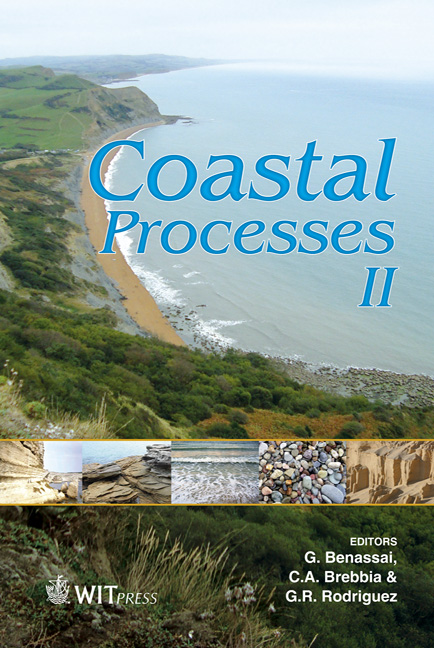Far-infragravity And Infragravity \“pulses” In A Rip Current
Price
Free (open access)
Transaction
Volume
149
Pages
13
Page Range
123 - 135
Published
2011
Size
773 kb
Paper DOI
10.2495/CP110111
Copyright
WIT Press
Author(s)
B. Greenwood, R. W. Brander & E. Joseph
Abstract
Rip currents are narrow, jet-like flows directed offshore through the breaker zone, often fed by shore-parallel feeder currents and forced by variable alongshore set-up induced by breaking gravity waves. Current speeds are not \“quasi-steady”, but \“pulse” at a range of frequencies, some much lower than that of the incident waves. Relatively few field measurements identify these low frequency motions and even fewer record their sediment transport potential. Cross-shore velocities and sediment concentrations measured in a rip neck are used to: (a) identify the frequencies of these pulses and (b) assess the role of low frequencies in the transport of suspended sediment. Velocities at z = 0.13 and 0.39 m and concentrations at z = 0.13, 0.26 and 0.39 m were recorded continuously at 4 Hz over several hours in a rip neck at Bennett's Beach, NSW, Australia. Spectral and cross-spectral analyses of ~33-minute records were used to identify low frequency modulations of the velocity and concentration fields, as well as the suspended sediment flux. A lack of spectral variance around 0.005 Hz marked the partition frequency between infragravity (IG) and far-infragravity (FIG) motions. At high tide when the mean cross-shore current at z = 0.13 m was at its maximum (~0.38 m s-1): (a) the dominant frequency was a FIG pulse at 0.0026-0.0028 Hz (~5-6 minutes). (b) IG motions also occurred with a 0.0199 Hz (~50 s) pulse dominating. (c) near the bed, concentrations were strongly modulated at FIG frequencies, but at higher elevations, the spectra were distinctly \“red”. (d) co-spectra revealed an offshore sediment flux dominated by a FIG pulse centered at 0.00244 Hz (~6-7 minutes). IG pulses between 0.0129
Keywords
rip currents, sediment concentrations, far-infragravity and infragrairy pulses, sediment flux





